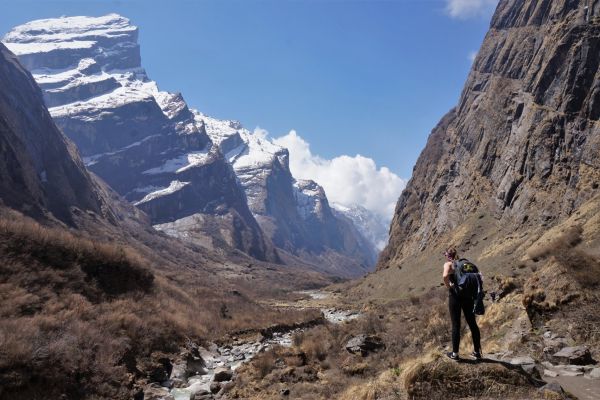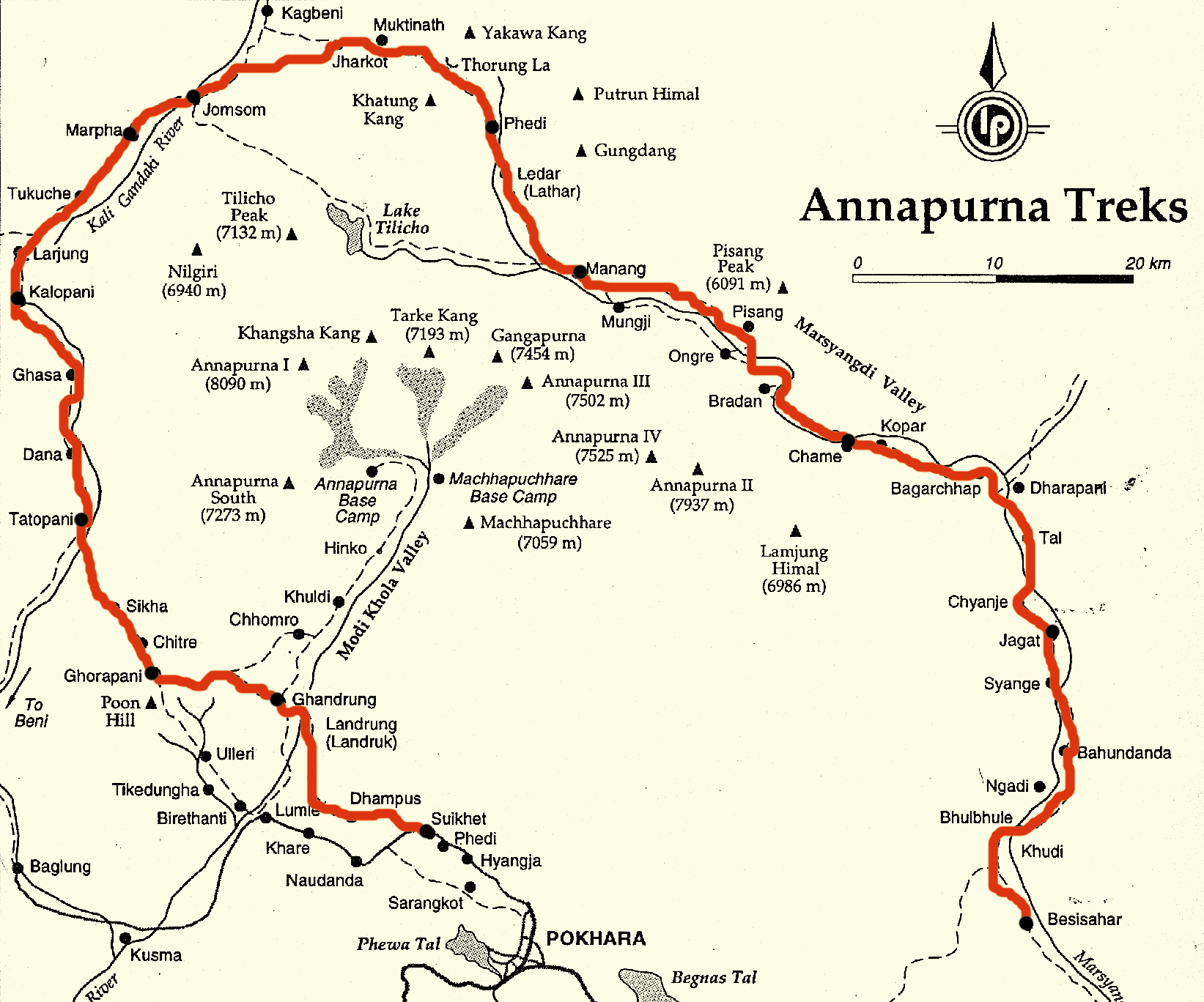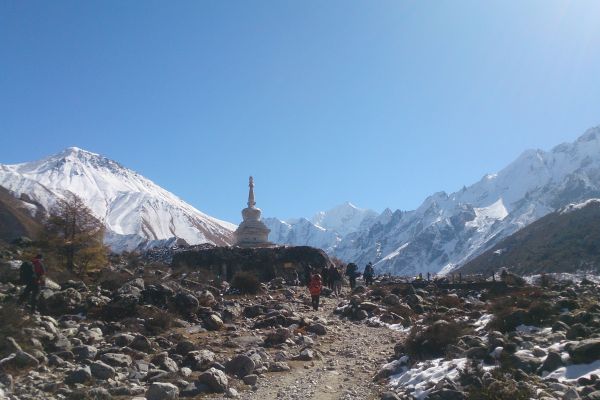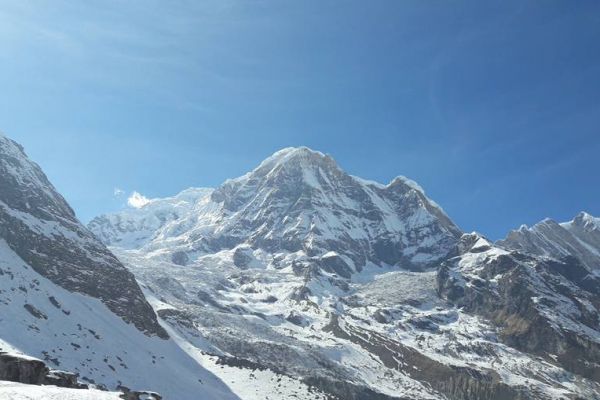- Trip Code : NTEACT02
- Trip Duration : 15 Days
- Trip Level : Demanding
- Trip Max Altitude : 5600
- Trip Start Location : Kathmandu
- Trip End Location : Kathmandu
- Trip Route : Kathmandu-Besisahar-Manang-Throng-La Pass- Jomsom-Pokhara
- Trip Best Season : March-April & August-November
Trip Highlights
- A scenic drive from Kathmandu to Beshisahar and a jeep drive to Chame
- Exploration of low and high altitude like tropical to arctic.
- See some world highest mountain.
- Visit some centuries-old monasteries and temples.
- Visiting high altitude lakes and see alpine migratory ducks.
- Crossing world largest pass Throng-La 5416m/17764ft.
- Visit the most sacred temple of Muktinath.
- Trek through the windy valley.
- See the arid land of Nepal.
Trip Information
The Annapurna Circuit Trek is one of the most famous adventurous trekking destinations throughout the decades. The Annapurna Circuit trek is a universally appreciated adventurous trekking destination, that lets you experience different kinds of climatic regions, encounter typical indigenous people of the Himalayans, and know about their unique culture and traditions, and many more. Manang region is basically a home place to ethnic people such as; Gurung, Thakali, Magar, Limbu, Rai, and Sherpa, all these people are heavily influenced by Tibetan Culture. Besides these features of Annapurna Circuit, climbing thought-provoking Thorung La Pass, situated at the elevation of 5416m, and have a boundless Mountains Landscape provide us with a great sense of accomplishment. Annapurna is one of the 10th highest mountains in the world. This classic Himalayan trek in the Annapurna region lets you explore beautifully the Annapurna massif and climb above 8000m peaks which is a major attraction to adventurous enthusiasts. Since early 1980, it opened for foreigners and get incredible popularity among international Trekkers and Travelers. Trekking inside the Snowy Horizon is really amazing which compensates for physical challenges during the trial period. The cultural impressions and stunning nature make this trekking worth visiting. The Annapurna Circuit Trek provides an opportunity to explore the ancient Braga Monastery. It is one of the oldest monasteries in the Manang region. Besides this, you can visit a famous Muktinath Temple, a Pilgrimage site worshipped by Hindu and Buddhist devotees.
The Annapurna Circuit Trek starts from the tropical valley of Khudi by following the beautiful Marsyangdi Valley and ultimately reach Thorong La (5416m), the world's largest pass. Our trail passes many dynamic Himalayan settlements through delightful Kaligandaki Valley and Marsyangdi valley.
Note:- Above mention information is just the guideline and a standard template of what we provide. The trip can be customized at your request to accommodate your specific requirements.
Short Itinerary
- Day 01 - Kathmandu: Sightseeing and trek Preparation
- Day 02 - Drive to Khudi (800m/2,624ft): 7- 8 hours
- Day 03 - Khudi to Sirung (2200m/7216 ft): 6 - 7 hours
- Day 04 - Sirung to Jagat (1,300m/4265ft): 6 - 7 hours
- Day 05 - Jagat to Dharapani (1,960m/6,430ft): 7-8 hours
- Day 06 - Dharapani to Chame (2,710m/8,891ft): 5 - 6 hours
- Day 07 - Chame to Pisang (3,300m/10824ft): 5 - 6 hours
- Day 08 - Pisang to Manang : 6 - 7 hours
- Day 09 - Manang: Acclimatization day
- Day 10 - Manang to Yak Kharka (4,110m/13,484ft): 3 - 4 hours
- Day 11 - Yak Kharka to Thorong Phedi (4,600m/15,092ft): 3 - 4 hours
- Day 12 - Thorong Phedi to Muktinath (3,800m/12,467ft) via Thorong La pass (5416m/17764ft): 7 - 8 hours
- Day 13 - Muktinath to Marpha (2,670m/8,760ft): 4 - 5 hours
- Day 14 - Marpha to Kalopani (2,530 m/8,300 ft): 5 - 6 hours
- Day 15 - Kalopani to Tatopani (1,200m/3,937ft): 6 - 7 hours
- Day 01 Kathmandu: Sightseeing and trek Preparation
- Day 02 Drive to Khudi (800m/2,624ft): 7- 8 hours
- Day 03 Khudi to Sirung (2200m/7216 ft): 6 - 7 hours
- Day 04 Sirung to Jagat (1,300m/4265ft): 6 - 7 hours
- Day 05 Jagat to Dharapani (1,960m/6,430ft): 7-8 hours
- Day 06 Dharapani to Chame (2,710m/8,891ft): 5 - 6 hours
- Day 07 Chame to Pisang (3,300m/10824ft): 5 - 6 hours
- Day 08 Pisang to Manang : 6 - 7 hours
- Day 09 Manang: Acclimatization day
- Day 10 Manang to Yak Kharka (4,110m/13,484ft): 3 - 4 hours
- Day 11 Yak Kharka to Thorong Phedi (4,600m/15,092ft): 3 - 4 hours
- Day 12 Thorong Phedi to Muktinath (3,800m/12,467ft) via Thorong La pass (5416m/17764ft): 7 - 8 hours
- Day 13 Muktinath to Marpha (2,670m/8,760ft): 4 - 5 hours
- Day 14 Marpha to Kalopani (2,530 m/8,300 ft): 5 - 6 hours
- Day 15 Kalopani to Tatopani (1,200m/3,937ft): 6 - 7 hours
Price Includes
- Airport pick up and drop off services. Transport: Kathmandu - Besihahar - Pokhara-Kathmandu by tourist bus.
- 1 night's hotel accommodation in Pokhara with breakfast. Guesthouse accommodation during the trek
- Full board meal arrangements during the trek (Main course: breakfast, lunch and dinner)
- 1 professional, licensed, English-speaking trekking guide. A well-experienced English-speaking assistant guide if the group size exceeds 5 people
- All applicable taxes, necessary trekking permits, Annapurna Conservation Area fees and Trekkers' Information Management System (TIMS) card
- First aid medical kit, oxymeter to check your pulse, heart rate and oxygen saturation in high altitude
- In the worst case, we will help you with all rescue and evacuation arrangements
- Unique Adventure's sleeping bag, down jacket, duffel bag & area trekking map (to be returned after the trip is over)
Price Does not Include
- Nepal visa (USD 25 for 15 days and USD 40 for 30 days)
- Your international flights to and from Nepal
- Travel insurance (for helicopter evacuation if needed during the trek
- Hotels in Kathmandu
- Porters to carry luggage (you can add a porter when booking)
- Bar and beverage bills, tea / coffee / drinking water. Personal expenses such as laundry, telephone, internet, battery charger, hot shower etc
- Tips for guide, porter, driver
Trekking equipment and clothing needed for this trek
- Warm fleece hat with ears cover or balaclava.
- Sun hat and scarf to cover face.
- Good polarized sunglass (uv protector).
- Cold proof polypropylene tshirt (2/2 half and full sleeve).
- Wind proof fleece jacket and thermal down tshirt.
- waterproof shell jacket and Gore-tex jacket.
- Light weight poly-liner gloves and wool or fleece gloves(1 pair each).
- A pair of expedition mittens.(waterproof shell).
- Underwears.
- Light weight cotton pants and hiking shorts.(1 pair each)
- A pair of light and expedition thermal bottoms.
- A pair of fleece trousers and A pair of waterproof shell pants.(breathable fabric)
- A pair of socks.(Thin lightweight inner and thick warm wool hiking socks).
- Hiking shoes with spare laces.
- Light sandals/shoes for camp.
The price per person for the Small group Journey is fixed as stated below. There is also the option of private and tailor made journey best suited for you, your family and friends. The discount is subjected to increase with the number of people in your group. Bigger the group better the discount so group bookings are highly encouraged.
Frequently Asked Questions
- All your departure is guaranteed to run?
- Do I need to tip my guide and porters? How much would that be?
- Can I add extra days to my trek or trip?
- Do you use Yaks and porters on the trek or do we carry all of our own gear?
- Will there be a place to store items clothing not require for the trek?
- Can I charge my digital camera, mobile or other equipment on my trip?
- Is there any communication while we are on trekking?
- Do you guys have a PAC portable altitude chamber?
- If I am sick can I continue the trek next day after a day rest?
- What if I am badly sick in the Mountain?
- Is Nepal Travel Expedition staff insured?
- What safety measures are in place? What safety equipment do your guides carry with them on the trek to deal with altitude sickness/accident?
- Do your guide have trekking guide certificate from the government tourism center? Have they received first aid training for high altitude?
- What is the weather and temperature like in trekking?
- What is the best session for this trekking?
- What is your cancellation policy?
- Is it possible to reserve a trip now pay deposit later or do I have to pay deposit at booking reservation?
- Do we book own international flights to and from Nepal?
- What is the alternative option if my flight to and from Lukla is delayed or cancelled?
- What mode of transportation do you use?
- How much additional money do I need per day for the trek?
- What are the opportunity will I have for the shower along the trek?
- What is the drinking water facilities in the mountain?
- If I am vegetarian, is that a problem?
- Is the food in mountain prepare to international standard in terms of safety?
- What are the Toilet facilities in the tea house or guest house in the trekking route?
- What short of accommodation can I expect in Kathmandu and in the trekking?
- What types of extra document do I need?
- Can I obtain visa for Nepal upon on arrival at airport?
- Will somebody come to pick me up at the airport upon my arrival?
- What types of Shape do I need to be in this trip?
Why this trip make different?
Nepal Travel Expedition works closely with One of the main supporter's Charity service in Nepal. And contribute 10% of the tour cost for Orphan Childrens (sherpa Outdoor Foundation) We support them in many different ways.
Donation and Charity!
Nepal Travel Expedition donates 10% of its annual revenue to Sherpa Outdoor Foundation Orphan Children Home Which is Located in Lalitpur one can visit while you are in Nepal after or before the trip. We support Children's for Food, School, Clothes, Medicine also supporting stationery materials to Government School which is located at Lamjung district trying to build a library for them where they could find a different book to read. For this project, we are trying to collect donations.
Sponsorship and Partnership (volunteering programmed)
One of the major activities of Sherpa outdoor Children home in Lalitpur is fully conducted and collaborate with Nepal Travel Expedition and sister concern organization Nepal wildlife safari. The Volunteering concern programmed delivered by Nepal Travel Expedition and Sherpa Outdoor Foundation aims to mobilize a team of experts and interested individuals as an economic measure in providing human capital for education, health, community to share teaching skill various Government school in a different part of the country and community to delivered humanity skills also in our children home.







